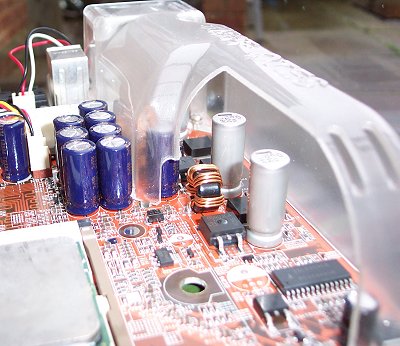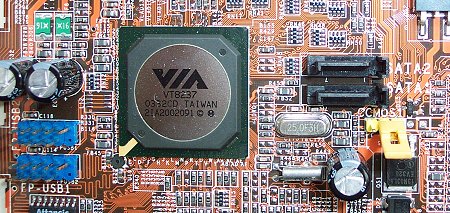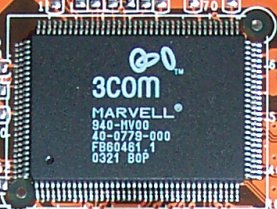Layout and Features
We've got a fairly good idea that the ABIT KV8-MAX3 is going to big on features. The question is how will they be amalgamated into a tight PCB space. Let's find out.
ABIT certainly wants to make the most out of the board estate available here. ABIT also employs an OTES (Outside Thermal Exhaust System) to cool the right-hand side of the board. A fan on the rear blows cooler air in and attempts to keep critical power-smoothing components cooler than would otherwise be the case. There's little need for such intervention for running at default speeds; the OTES system is designed for those that want to push the board past its rated specs. We do like the use of high-quality Rubycon capacitors, though.

Here's a better shot illustrating the above point. Cooler air is blown across the capacitors and 4-phase PWM supply. Our sample board is v1.1. From what we can gather, ABIT's original design called for a larger OTES shell that interfered with a number of coolers. This design has been cut away to provide easier access to the CPU and surrounding areas. The sample also arrived without the standard Athlon 64 plastic retention bracket. You can clearly see the two large holes into which it would normally be screwed in. It's not too much to say that it was a pain in the posterior to attach a Zalman 7000Cu heatsink to the board. Screws had to be pushed threw its holes, through the KV8's holes and then secured on the underside via two nuts. That's not straightforward with only a single pair of hands.

ABIT houses the standard 20-pin and 4-pin power connectors right up at the edge of the OTES shell. It's certainly not the easiest place to get to and wires need to traverse the socket area. The 4-pin plug, in particular, can be a little difficult to remove. The VIA K8T800 is a basic two-bridge design. The K8T800 Northbridge is connected to the CPU via AMD's HyperTransport buslink. ABIT decides that it is in need of some active cooling. The round cooler gets close to interfering with a couple of aftermarket heatsinks.

We've seen previous Biostar and EPoX S754 boards use only 2 DIMM slots for a maximum of 2GB system memory. ABIT decides to use three. That creates a problem in itself, especially with the Zalman 7000Cu heatsink. What the above picture is attempting to show is that once the heatsink is secured on the CPU, the first DIMM slot (nearest the cooler) is totally unusable. It's impossible to get a DRAM stick in place. Whether that's bad heatsink design or layout is a subjective issue.
Another problem is the proximity of the DIMM slots to the AGP card. A Hercules 9800XT blocks off access to one of the DIMM slots. The card needs to be removed if the memory is to be taken out in the correct manner. One can still get at it by pulling it out from one side. That isn't ideal, is it ?. It's as if ABIT is trying to do too much with limited space.

The other half of the VIA double-act is the VT8237 Southbridge. On-chip RAIDable SATA is one of its more alluring qualities. A couple of USB2.0 headers sit to the left and ABIT's excellent big-headed jumper that clears CMOS is to the right. We wish that everyone else would adopt these. They make resetting the board that much easier.

It wouldn't be a MAX3 if it didn't have a whole shedload of features tacked on. Kind of like Agent Smith in Matrix Reloaded, ABIT, with respect to SATA, appears to say more, more, more. Silicon Image's 4-port SATA controller mimics the VIA's RAID0 and RAID1 spec. but it goes further and offers RAID0+1 (4 ports help in this regard). Lovely.
ABIT's µ GURU monitoring chip is a much-touted feature. It allows one to monitor and manipulate a whole multitude of system-specific settings from an easy-to-use OS GUI. We had a look at it in our ABIT AI7 review. It's the same technology that's at play here. We're not too keen on the location of the floppy port. It obscures the useful debug LED that provides basic troubleshooting during the POST sequence.
The KV8-MAX3 houses 5 PCI slots. There's a large gap between the AGP port and the first PCI slot. We like this. It allows the first slot to be used with standard AGP cards in place. In Max3 tradition, a Texas Instruments 3-port single-chip controller sits in between the port and slot. Kind of reminiscent of the ABIT IT7-MAX.


The VT8237 Southbridge is pretty good in most respects. It doesn't, as yet, feature on-chip Gigabit LAN. ABIT uses 3COM's decent 3C940 single-chip LOM for Gigabit networking duties. The Realtek ALC658 6-channel sound CODEC is driven by VIA's S.B. We just get the nagging feeling that ABIT isn't maximising the board's potential. This is the MAX3 - the pinnacle of ABIT's design philosophy. It seems fitting that the Envy24 should be here in the Realtek's place.

Incorporating the OTES cooling system required a redesign of the I/O section. Something had to give, and it was the Parallel and Serial ports that got the dreaded chop. We're not too convinced that it was the right idea, some users still require these legacy ports. Otherwise, it's classic ABIT. PS/2 ports, dual optical S/PDIF connections, plentiful sound outputs, 4 x USB2.0 and a single FireWire port.
A decent enough board, but it's not too hot in the layout department.









